24 start with P start with P
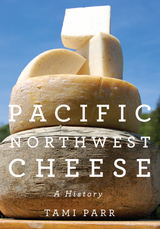
For years, farmers in the Pacific Northwest made and sold cheese to support themselves, but over time the craft of cheesemaking became a profitable industry and production was consolidated into larger companies and cooperatives. Eventually, few individual cheesemakers were left in the region. In the late sixties and early seventies, influenced by the counterculture and back-to-the-land movements, the number of small farms and cheesemakers began to grow, initiating an artisan cheese renaissance that continues today.
Along with documenting the history of cheese in the region, Parr reveals some of the Pacific Northwest’s untold cheese stories: the fresh cheese made on the Oregon Trail, the region’s thriving blue cheese and regional swiss cheese makers, and the rise of goat’s milk and goat’s milk cheese (not the modern phenomenon many assume it to be).

Pancake traverses over centuries and civilizations to examine the culinary and cultural importance of pancakes in human history. From the Russian blini to the Ethiopian injera, Albala reveals how pancakes have been a perennial source of sustenance from Greek and Roman eras to the Middle Ages through to the present day. He explores how the pancake has gained symbolic currency in diverse societies as a comfort food, a portable victual for travelers, a celebratory dish, and a breakfast meal. The book also features a number of historic and modern recipes—tracing the first official pancake recipe to a sixteenth-century Dutch cook—and is accompanied by a rich selection of illustrations.
Pancake is a witty and erudite history of a well-known favorite and will ensure that the pancake will never be flattened under the shadow of better known foods.
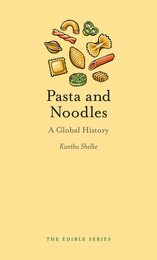
Shelke traces the evolution and examines the scientific qualities of this highly adaptable staple. From there she guides us from roadside noodle stalls in Singapore to an age-old traditional pasta company in Parma, Italy; from a state-of-the-art Japanese manufacturer to pasta makers in Brazil, Mexico, and United States. She then takes the quest into our homes, offering a bonanza of recipes from around the world suitable to casual and intrepid home-cooks alike. A toothsome look at the world’s comfort food, Pasta and Noodles reveals little known facts, tasty titbits, and cultural lore that will have you feeling satiated, indeed.

“In the fifties, sleek Mixmasters were replacing rusty eggbeaters, and new pressure-cookers blew their tops in kitchens all over town. There were kids everywhere, and new ‘ranch-style’ houses filled vacant lots. . . . Turquoise Studebakers and dusty-rose Chevy BelAirs with flamboyant fins and lots of chrome replaced dark pre-war cars. Cameras took color snapshots instead of black-and-white. We wore red canvas tennis shoes and lemon yellow shorts, and bright blue popsicles melted down our chins.” —from the Introduction
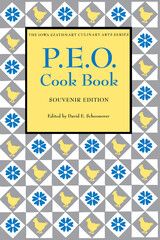
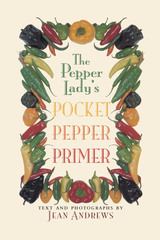
More than a quarter of the people on earth eat peppers every day of their lives, and true pepper lovers are always looking for better-tasting, hotter peppers. This handy, reliable guide makes finding them easy, as capsicum expert Jean Andrews shows you how to identify and use 42 peppers, both fresh and dried, commonly available in North American markets.
Andrews describes each pepper in detail, starting with its size, color, fruit shape, flesh, and pungency. She gives its common names, sources, and uses, and indicates other peppers that can substitute for it in recipes. Drawing on her vast store of pepper lore, she also includes notes and anecdotes about each pepper. Her color photographs illustrate all of the peppers.
In addition to the species descriptions, Andrews offers practical guidance on selecting and storing, roasting and rehydrating, and growing and harvesting peppers. She explains pepper nomenclature, describes the pungency factor, and notes the significance of color, aroma, flavor, and nutrition.
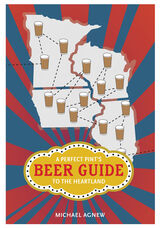
- Agnew's exclusive choices on which beers to try at each location
- Entries on every brewery's history and philosophy
- Information on tours, tasting rooms and attached pubs, and dining options and other amenities
- A survey of each brewery's brands, including its flagship beer plus seasonal brews and special releases
- Brewery equipment and capacity
- Nearby attractions
In addition, Agnew sets the stage with a history of Midwestern beer spanning the origins of the immigrant brewers who arrived in the 1800s to the homebrewers-made-good who have built a new kind of brewing culture founded on creativity, dedication to quality, and attention to customer feedback.
Informed and unique, A Perfect Pint's Beer Guide to the Heartland is the essential companion for beer aficionados and curious others determined to drink the best the Midwest has to offer.
Includes more than 150 full color images, including the region's most distinctive beer labels, trademarks, and company logos.
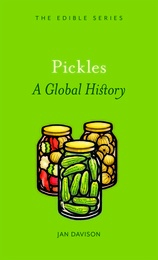
In Pickles, Jan Davison explores the cultural and gastronomic importance of pickles from the earliest civilizations’ brine-makers to twenty-first-century dilettantes of dill. Join Davison and discover the art of pickling as mastered by the ancient Chinese; find out why Korean astronaut Yi So-yeon took pickled cabbage into space in 2008; learn how the Japanese pickle the deadly puffer fish; and uncover the pickling provenance of that most popular of condiments, tomato ketchup. A compulsively consumable, globe-trotting tour sure to make you pucker, Davison’s book shows us how pickles have been omnipresent in humanity’s common quest not only to preserve foods, but to create them—with relish.

Apple pie. Pumpkin pie. Shepherd’s pie. Chicken potpie. Sweet or savory, pies are beloved; everyone has a favorite. Yet despite its widespread appeal there has never been a book devoted to this humble dish—until now.
Janet Clarkson in Pie illustrates how what was once a purely pragmatic dish of thick layers of dough has grown into an esteemed creation of culinary art. There is as much debate about how to perfect the ideal, flaky pastry crust as there is about the very definition of a pie: Must it have a top and bottom crust? Is a pasty a pie? In flavorful detail, Clarkson celebrates the pie in all its variations. She touches pon the pie’s commercial applications, nutritional value, and cultural significance; and she examines its international variations, from Britain’s pork pie and Australia and New Zealand’s endless varieties of meat pie to the Russian kurnik and good old-fashioned American apple pie.
This delectable salute to the many pies enjoyed the world over will satisfy the appetites of all readers hungry for culinary history and curious about the many varieties of this delightful food, and it just might inspire them to don aprons and head for the stove.
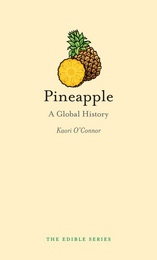

An engaging look at the history of the piñon pine and its ecosystem. Combining natural history and observations of the cultural importance of the tree to both native Indians and European settlers, Lanner provides information on the management of the tree and its interdependence with the birds and animals of the piñon-juniper woodland. Science, cultural history, and ecologicall issues, plus delicious recipes using the piñon pine nuts, make for a concise natural and cultural history of the piñon pine.

Originally a food for the poor in eighteenth-century Naples, the pizza is a source of national and regional pride as well as cultural identity in Italy, Helstosky reveals. In the twentieth century, the pizza followed Italian immigrants to America, where it became the nation’s most popular dish and fueled the rise of successful fast-food corporations such as Pizza Hut and Domino’s. Along the way, Helstosky explains, pizza has been adapted to local cuisines and has become a metaphor for cultural exchange. Pizza also features several recipes and a wealth of illustrations, including a photo of the world’s largest and most expensive pizza—sprinkled with edible 24-karat gold shavings and costing over $4000.
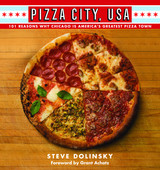
And in Chicago, there are as many destinations for pizza as there are individual preferences. Each of the city's seventy-seven neighborhoods is home to numerous go-to spots, featuring many styles and specialties. With so many pizzerias, it would seem impossible to determine the best of the best.
Enter renowned Chicago-based food journalist Steve Dolinsky! In Pizza City, USA: 101 Reasons Why Chicago Is America's Greatest Pizza Town, Dolinsky embarks on a pizza quest, methodically testing more than a hundred different pizzas in Chicagoland. Zestfully written and thoroughly researched, Pizza City, USA is a hunger–inducing testament to Dolinsky's passion for great, unpretentious food.
This user-friendly guide is smartly organized by location, and by the varieties served by the city's proud pizzaioli–including thin, artisan, Neapolitan, deep-dish and pan, stuffed, Sicilian, Roman, and Detroit-style, as well as by-the-slice. Pizza City also includes Dolinsky's "Top 5 Pizzas" in several categories, a glossary of Chicago pizza terms, and maps and photos to steer devoted foodies and newcomers alike.
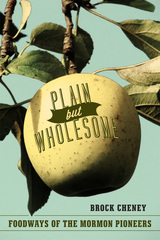
Plain But Wholesome presents a groundbreaking foray into Mormon history. Brock Cheney explores the foodways of Mormon pioneers from their trek west through the arrival of the railroad and reveals new perspectives on the fasci-nating Mormon settlement era. Relying on original diaries, newspaper accounts, and recipe books from the 1850s, Cheney draws a vivid portrait of what Mormon pioneers ate and drank. Although other authors have sketched the subject before, this portrait is the first effort that might be described as scholarly, though the lively prose will interest a broad general audience.
Presented here are the first explicit descriptions of the menus, food processes, and recipes of the Mormon pioneers. While many have supposed that earlier pioneer foodways continued to be handed down through Mormon families, Cheney has confirmed traditions going back generations and covering more than a century. The book also exposes myths and clichés about pioneer piety and hardships, as Cheney examines such pioneer extravagances as fresh “oysters on the half shell” and pioneer trends of alcohol consumption.
A perfect gift for the history buff or Dutch oven chef, Plain But Wholesome will also prove its place among scholars and historians. With its rollicking blend of historical source material and modern interpretation, this book will entertain and educate novice and expert alike.

Stone takes us back to the early polytheistic religions and the important role that pomegranates had in their rituals. From there he shows how they came to be held in high esteem in Judaism, Christianity, and Islam alike, examining exciting new findings that further cement their importance: for instance, many historians believe now that it was a pomegranate, not an apple, that was the forbidden fruit in the Garden of Eden. Stone examines the allure that the pomegranate has had to a fascinating cast of famous figures, from ancient Assyrian King Ashurnasirpal to Tudor Queen Anne Boleyn, from Sandro Botticelli to Salvador Dalí. Drawing on text, image, and taste, Pomegranate is a cornucopia of strange and fascinating stories about a very special fruit.

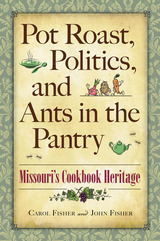
When is a cookbook more than just a cookbook? When it’s a gateway to our culinary heritage. For well over a hundred years, Missouri’s cookbooks have helped readers serve up tasty dishes to the state’s tables, but these publications also document the evolution of our kitchens and households.
Pot Roast,Politics, and Ants in the Pantry, a treasure trove of anecdotes and nuggets of historical information about cookery in the Show-Me State, draws from more than 150 publications to reveal Missouri’s cookbook heritage and to deliver a generous sampling of recipes. Carol Fisher and John Fisher look back to manuscript cookbooks from 1821 St. Louis, then progress through the years and around Missouri before arriving at today’s online recipes. Along the way, they dish out servings of kitchen medicine, household hints, and cookbook literature gleaned from the state’s cache of culinary gems.
From handwritten family recipe collections and mimeographed publications to glossy color editions, the texts the Fishers have obtained from libraries and historical societies as well as their own extensive cookbook collection include such curiosities as the Julia Clark Household Memoranda Book from the William Clark papers, an 1880 production by the Ladies of St. Louis called My Mother’s Cookbook, Mary Foote Henderson’s Practical Cooking and Dinner Giving, and Albert E. Brumley’s All-Day Singin’ and Dinner on the Ground. They tell how various ethnic communities raised money by creating cookbooks, how the state’s Beef Council and Pork Association put recipes on the Internet, and how restaurants like the Blue Owl in Kimmswick and Stephenson’s Apple Farm Restaurant near Kansas City enhanced their reputations with their own cookbooks. Festival cookbooks, company cookbooks, even cookbooks tied to world events—they’re all here in one delightful book.
In this vastly entertaining review, readers will learn where to find recipes for dandelion wine, mock turtle soup (requiring a large calf’s head split open by the butcher), and vinegar pie—as well as the curative properties of potato water, tips for raising chickens in the basement, and even “how to cook a husband.” An extensive bibliography includes information to help readers track down the books discussed and also those on their own wish lists.
Pot Roast, Politics, and Ants in the Pantry: Missouri’s Cookbook Heritage shows how, instead of being just collections of recipes, cookbooks provide history lessons, document changing food ways, and demonstrate the cultural diversity of the state. From Julia Clark’s simple frontier recipes for puddings and preserves to Irma Rombauer’s encyclopedic Joy of Cooking—originally self-published in Missouri—Carol Fisher and John Fisher have laid out a smorgasbord of reading pleasure for cookbook collectors, nostalgia buffs, and gourmands alike.

From obscure Pre-Columbian beginnings in the Andes Mountains to global popularity today, the story of the potato is one of rags to riches. In Potato, esteemed culinary historian Andrew F. Smith reveals the captivating story of a once lowly vegetable that has changed—and continues to change—the world.
First domesticated by prehistoric people in the Andes, the potato has since been adopted by cultures around the globe. For instance, the potato was aggressively adopted by cooks in India and China, where it has become a dietary staple. In fact, these two countries now stand as the world’s largest potato producers. Nonetheless, despite its popularity, in this era of both fast food and health consciousness, the potato is now suffering negative publicity regarding its low nutritional value. Its health benefits continue to be debated, especially considering that the potato is most often associated with the ubiquitous but high-calorie french fry.
Potato is a captivating read that provides a concisely written but thoroughly researched account of the history, economy, politics, and gastronomy behind this beloved starch—as well as recipes. As loaded with goodies as a well-dressed baked potato, this book is comforting and satisfying.
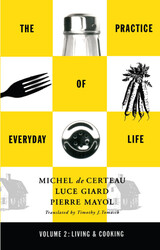
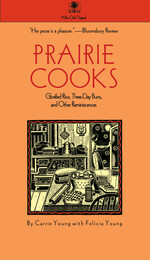
Growing up in a Norwegian American community imbued with the customs and foods of the Old Country, Carrie Young recalls how her mother and her neighbors skillfully blended Scandinavian with what they always called the American style of cooking. Young recounts how her mother, Carrine Gafkjen—after homesteading as a single woman in 1904—cooked for a large threshing crew during harvest season. Living and cooking around the clock in a cook car the size of a Pullman kitchen, she delighted the crew with her soda pancakes and her sour cream doughnuts, her fattigman (Poor Man's Cookies) and her fabulous North Dakota Lemon Meringue Pie.
During holidays lutefisk and lefse reigned supreme, but when the Glorified Rice fad swept the country in the thirties women broke new ground with inventive variations. And the short-lived but intensely experienced Three-Day Bun Era (when the buns became so ethereal they were in danger of floating off the plate) kept the Ladies Aid luncheons competitive. Whatever the times, in good years or bad, there was always the solace ofKaffe Tid, the forenoon and afternoon coffee time, when the table was set with smor og brod (butter and bread) and something sweet, like a Whipped Cream Cake or Devil's Food Cake with Rhubarb Sauce.
This book will appeal to those who feel nostalgia for a parent's or grandparent's cooking, to those who have a longing for the heartier fare of times past. The author's daughter, Felicia Young, who has "cooked Scandinavian since she was old enough to hold a lefse stick," has compiled and tested the seventy-two recipes accompanying this joyful memoir.

A social history of alcohol, identity, secularism, and modernization from the late Ottoman and early Turkish republican eras to the present day.
Prohibition in Turkey investigates the history of alcohol, its consumption, and its proscription as a means to better understand events and agendas of the late Ottoman and early Turkish republican eras. Through a comprehensive examination of archival, literary, popular culture, media, and other sources, it unveils a traditionally overlooked—and even excluded—aspect of human history in a region that many do not associate with intoxicants, inebriation, addiction, and vigorous wet-dry debates.
Historian Emine Ö. Evered’s account uniquely chronicles how the Turko-Islamic Ottoman Empire developed strategies for managing its heterogeneous communities and their varied rights to produce, market, and consume alcohol, or to simply abstain. The first author to reveal this experience’s connections with American Prohibition, she demonstrates how—amid modernization, sectarianism, and imperial decline—drinking practices reflected, shifted, and even prompted many of the changes that were underway and that hastened the empire’s collapse. Ultimately, Evered’s book reveals how Turkey’s alcohol question never went away but repeatedly returns in the present, in matters of popular memory, public space, and political contestation.

Fish & Game restaurant in Hudson, New York, is a leader in the local foods movement. Its core approach—engaging intimately with nature both wild and domestic, building relationships with farmers, and exploring the joys of fermentation—is one of interest to anyone, anywhere, who yearns to cook and eat better food. Established in 2013, Fish & Game, with its chef/owner Zakary Pelaccio and his co-chefs and partners Kevin Pomplun and Jori Jayne Emde, is already receiving national accolades and honors, including the 2016 James Beard Award for Best Chef: Northeast; 2015 James Beard Award finalist for Outstanding Restaurant Design; 2015 & 2016 Wine Enthusiast: America’s 100 Best Wine Restaurants; and 2014 James Beard Award semifinalist for Best New Restaurant.
Project 258: Making Dinner at Fish & Game presents an enticing selection of seasonal recipes, profiles of key producers who supply the restaurant, and a fascinating, beautifully illustrated look at the processes—both intellectual and culinary—behind the food at Fish & Game. Taking no shortcuts, Pelaccio and his staff handcraft many staple ingredients, including fish sauce, vinegars, maple syrup, and prosciutto. He explains how the methods and techniques practiced at Fish & Game can be applied to the food that grows wherever you live. If you ever wonder “what does this place taste like?,” let Project 258 be your guide and inspiration for locally based food sourcing and eating.


READERS
Browse our collection.
PUBLISHERS
See BiblioVault's publisher services.
STUDENT SERVICES
Files for college accessibility offices.
UChicago Accessibility Resources
home | accessibility | search | about | contact us
BiblioVault ® 2001 - 2024
The University of Chicago Press









